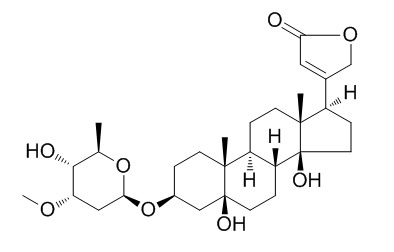Periplocymarin
Periplocymarin, a cardiac glycoside, has potential anti-cancer activity. Octreotide-conjugated periplocymarin demonstrates tumor selectivity and may be useful as a targeting agent to improve the safety profile of cardiac glycosides for cancer therapy.
Inquire / Order:
manager@chemfaces.com
Technical Inquiries:
service@chemfaces.com
Tel:
+86-27-84237783
Fax:
+86-27-84254680
Address:
1 Building, No. 83, CheCheng Rd., Wuhan Economic and Technological Development Zone, Wuhan, Hubei 430056, PRC
Providing storage is as stated on the product vial and the vial is kept tightly sealed, the product can be stored for up to
24 months(2-8C).
Wherever possible, you should prepare and use solutions on the same day. However, if you need to make up stock solutions in advance, we recommend that you store the solution as aliquots in tightly sealed vials at -20C. Generally, these will be useable for up to two weeks. Before use, and prior to opening the vial we recommend that you allow your product to equilibrate to room temperature for at least 1 hour.
Need more advice on solubility, usage and handling? Please email to: service@chemfaces.com
The packaging of the product may have turned upside down during transportation, resulting in the natural compounds adhering to the neck or cap of the vial. take the vial out of its packaging and gently shake to let the compounds fall to the bottom of the vial. for liquid products, centrifuge at 200-500 RPM to gather the liquid at the bottom of the vial. try to avoid loss or contamination during handling.
Green Chemistry2021, ISSUE 2.
J Adv Res.2021, 35:245-257.
Dicle Tip Dergisi2020, 47(2),423-430.
Fitoterapia.2021, 153:104995.
Phytomedicine.2019, 67:153159
Molecules.2021, 26(2):E255.
Food Res Int.2020, 128:108778
Inflammation.2015, 38(4):1502-16
J Cell Mol Med.2023, 27(10):1423-1435.
Cells.2023, 12(3):395.
Related and Featured Products
Oncotarget. 2016 Dec 27;7(52):86326-86338.
Octreotide-periplocymarin conjugate prodrug for improving targetability and anti-tumor efficiency: synthesis, in vitro and in vivo evaluation.[Pubmed:
27861145]
Cardiac glycosides could increase intracellular Ca2+ ion by inhibiting the Na+/K+ATPase to induce apoptosis in many tumor cells. However, narrow therapeutic index, poor tumor selectivity and severe cardiovascular toxicity hinder their applications in cancer treatment.
To improve the safety profile and tumor targetablility of cardiac glycosides, we designed octreotide conjugated Periplocymarin, a cardiac glycoside isolated from Cortex periplocae.
METHODS AND RESULTS:
The conjugate showed higher cytotoxicity on MCF-7 cells and HepG2 tumor cells (SSTRs overexpression) but much less toxicity in L-02 normal cells. Tissue distribution studies of the conjugate using H22 tumor model in mice showed higher accumulation in tumor and lower distribution in heart and liver than Periplocymarin. Furthermore, in vivo anticancer effects of the conjugate on mice bearing H22 cancer xenografts confirmed enhanced anti-tumor efficacy and decreased systemic toxicity.
CONCLUSIONS:
Altogether, octreotide-conjugated Periplocymarin demonstrated tumor selectivity and may be useful as a targeting agent to improve the safety profile of cardiac glycosides for cancer therapy.
Cancer Chemother Pharmacol. 2009 Sep;64(4):793-802.
Pro-apoptotic and cytostatic activity of naturally occurring cardenolides.[Pubmed:
19184018]
Cardenoliddes are steroid glycosides which are known to exert cardiotonic effects by inhibiting the Na(+)/K(+)-ATPase. Several of these compounds have been shown also to possess anti-tumor potential. The aim of the present work was the characterization of the tumor cell growth inhibition activity of four cardenolides, isolated from Periploca graeca L., and the mechanisms underlying such an effect.
METHODS AND RESULTS:
The pro-apoptotic and cytostatic effect of the compounds was tested in U937 (monocytic leukemia) and PC3 (prostate adenocarcinoma). Characterization of apoptosis and cell cycle impairment was obtained by cytofluorimetry and WB. Periplocymarin and periplocin were the most active compounds, Periplocymarin being more effective than the reference compound ouabain. The reduction of cell number by these two cardenolides was due in PC3 cells mainly to the activation of caspase-dependent apoptotic pathways, while in U937 cells to the induction of cell cycle impairment without extensive cell death. Interestingly, Periplocymarin, at cytostatic but non-cytotoxic doses, was shown to sensitize U937 cells to TRAIL.
CONCLUSIONS:
Taken together, our data outline that cardiac glycosides are promising anticancer drugs and contribute to the identification of new natural cardiac glycosides to obtain chemically modified non-cardioactive/low toxic derivatives with enhanced anticancer potency.
Biopharm Drug Dispos. 2014 May;35(4):195-206.
Periplocymarin is a potential natural compound for drug development: highly permeable with absence of P-glycoprotein efflux and cytochrome P450 inhibitions.[Pubmed:
24424534]
Periplocymarin, a cardiac glycoside isolated from Periploca sepium (P. sepium) and Periploca graeca (P. graeca), is a potential anti-cancer compound. The aim of the study was to investigate the potential for Periplocymarin to interact with P-glycoprotein (P-gp) and to inhibit cytochrome P450s known to be expressed in the human small intestine.
METHODS AND RESULTS:
The in vitro and in situ permeability of Periplocymarin were studied using Madin-Darby canine kidney (MDCK-II-WT) cells transfected with or without the human multidrug resistance (MDR1) gene and the single-pass perfused rat intestinal model. The cell system exhibited high functional activity and a net efflux ratio (NER) of 4.32 after transport of Rhodamine 123 (R123) (the P-gp substrate). Periplocymarin is highly permeable (Papp > 10 × 10(-6) cm/s; Peff(rat) > 5.09 × 10(-5) cm/s) and independent of P-gp influences. The NER at 100 μm Periplocymarin (0.8) was unchanged in the presence of cyclosporine A (a non-specific P-gp inhibitor) (0.82). In the single-pass intestinal model, the Peff (rat) of 5 μg/ml Periplocymarin (5.490 × 10(-5) cm/s) did not change in the presence of cyclosporine A (5.394 × 10(-5) cm/s). In the R123-inhibition assay, Periplocymarin did not competitively inhibit P-gp. The inhibitory potential of Periplocymarin on cytochrome P450 (CYP450s) was also studied. Periplocymarin (5, 50 μm) did not inhibit CYP1A2, CYP2C9, CYP2C19, CYP2D6 or CYP3A4.
CONCLUSIONS:
Thus, Periplocymarin is unlikely to encounter drug-drug interactions with P-gp and CYP450s. Periplocymarin could be taken forward for further studies in drug development to test bioavailability, Phase II enzyme interactions and additional transporter interactions.



